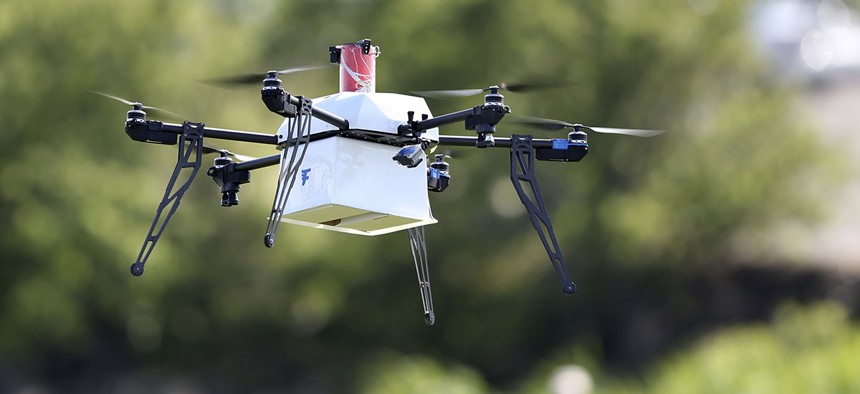FDA Is Looking Into Drones for Health Inspections

A drone aircraft with a payload of simulated blood flies during a ship-to-shore delivery simulation in Lower Township, N.J. Mel Evans/AP File Photo
But how drone-collected data will figure into the agency's old school processes is still being worked out.
Aerial drones could soon replace some of the Food and Drug Administration’s health inspectors, but the agency is still in the early stages of deciding how much data to collect and how to use it.
The federal agency must comply not only with regulations Federal Aviation Administration surrounding aerial unmanned vehicles—including where they can be flown—the FDA must also ensure that its technology complies with the 2014 Food Safety Modernization Act’s guidelines for inspections, Cory Milam, the FDA’s Office of Innovation Director, said at a Wednesday event hosted by trade group ACT-IAC.
Drones could help detect food poisoning or disease outbreaks before they happen, maybe even by scanning riverbeds for sewage contamination near seafood sources, Milam said.
» Get the best federal technology news and ideas delivered right to your inbox. Sign up here.
“We have done it the old school way for so long. We send someone out somewhere with a camera and they have their paper,” she said, though she noted that some parts of the inspection process are mobile device-based. “It would take hours for them to walk a rural farm area—maybe even days.”
FDA's drone strategy is still in the proof-of-concept stage, but the agency is working on making sure the data drones collect is accurate and defining how it could be used to replace human decision making.
“If we’re going to use that data to actually tell somebody, ‘We’ve got to shut you down because you haven’t met the compliance initiatives’ around a certain thing that we’re inspecting, or if we found contamination in the product and we’re telling you to take the product off the market because we found pollution in water sources ... We have to be really strategic.”
But FDA still hasn’t decided whether drones qualify as “technology” or as “aircraft,” which are both subject to different guidelines, Milam explained.
The agency is also concerned about how much data should be kept behind a firewall, especially when FDA has agreements with some industry partners to keep certain information—like trade secrets—confidential.
And transmitting the data from the drones requires a robust wireless connection, Milam added.
Implementing drones can be challenging because much of FDA’s staff are research scientists, many of whom are focused on preventing disease outbreaks. “We’re not aviation specialists.”


